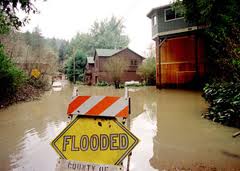If you have been told that your home is located in a flood zone, please call Ringgold Land Surveying to get an elevation certificate completed for your house. Call us at (706) 222-3522 or fill out the contact form on the right.
“…this [elevation survey & certificate] helped [our client] a lot – quote went down to $460 – down from $2599.” – Staci Herring, State Farm Insurance
Flood determination through an elevation survey and flood maps
Recently many areas of the state completed the process of updating the FEMA Flood Insurance Rate Maps (FIRMs) for identifying the areas of potential flooding based on the 1-percent chance storm event. After this mapping is completed, then an elevation survey can be done by a land surveyor to determine the elevation of the home related to this flood elevation.
The base flood elevation has been known in the past as the 100 year flood and is also known as the Special Flood Hazard Area (SFHA). When you get a certain amount of rain equalling the 1-percent storm, the flood water will always come to a certain elevation near your home, known as the Base Flood Elevation (BFE). FEMA had been required to assess the flood hazard maps every 5 years, but, because of funding shortfalls, it’s been over 15 years for some communities. For those homeowners with a mortgage, purchasing flood insurance is mandatory in a participating community if the loan is federally insured or the lender is regulated by the federal government.
Flood insurance is highly advisable even if you’re not required to purchase it but you are located near a stream or lake. Play it safe and get an elevation survey for your area. Remember, the 1-percent chance storm has a 1 percent chance of being met OR EXCEEDED in any year. Over a 30 year mortgage there is a 26% chance of having a flood that overtops the base flood elevation. Morttnge insurance rates are lower if your finished floor is above the base flood elevation. Therefore, if you are four feet above the BFE the rates should be lower than if you were at or below the BFE.
A $300 policy may well be worth the peace of mind it brings. Your homeowner insurance DOES NOT cover any flood damage. You should also know that just because you’re above the BFE and far away from a running stream, many dry ditches have caused significant damage to a home during a flash flood. Atnin, your homeowner policy is useless in this case but a flood policy would cover this damage. An elevation survey produces an elevation certificate which is needed before you apply for a flood policy, thus it will give you an idea of the flood risks of your location.
Purchasing flood insurance is mandatory…
…if the loan is federally insured or the lender is regulated by the federal government
Flood insurance quote requires an elevation survey and elevation certificate report
As stated above, your mortgage company may be required to ask you to purchase flood insurance. They would want you to do so because of the protection it affords them also. You should know that the mortgage lender may require flood insurance even if you’re not in a flood hazard zone. This is their prerogative. The rates should be low in this case, but there are some costs nonetheless. Now that you know a little about the situation, does this affect you directly? If you are currently shown in or near a flood hazard zone, NOW is the time to act. The following are the possible situations in which you may find yourself:
1. Out of the flood hazard zone completely. This is great. In this case there is no requirement for the purchase of flood insurance. But, as we said earlier, if there is ANY risk you might want to consider it. An evaluation of your risk is quick and easy.
2.You’re lot is currently shown in a flood hazard zone on the FEMA flood maps. This puts you under the requirement for flood insurance. Your situation may now be one of the following:
a.Your lot is “in” the flood hazard zone but the lowest adjacent grade (LAG) around your house is “out” or above the base flood elevation (BFE). In this situation, it is possible that the flood insurance requirement may be removed. This process is called a Letter of Map Amendment (LOMA).
b.Your lowest adjacent grade (LAG) is below the BFE but the lowest finished floor elevation (FFE) is above the BFE. In this case you need to purchase flood insurance. An elevation survey and an Elevation Certificate is necessary as a way to determine your premium rate.
c.Your lowest finished floor elevation (FFE) is below the BFE. This case is similar to 2.b. above but the flood risk is higher. Atnin, get an elevation survey to determine your premium rate.
If you’re in any of the situation 2 scenario’s above, the first step is to get an elevation survey and flood zone determination. This process is done by a licensed land surveyor who will measure the elevation of your finished floor elevation and the lowest adjacent grade to determine your location relative to the flood hazard zone. This elevation survey will produce an Elevation Certificate that can be used to either complete the LOMA process or allow your insurance agent to quote the flood insurance premium rate.
One last money saving tip – if the maps haven’t been printed yet you have the opportunity to obtain insurance under the old rates. Then, when the new maps become effective, your rates will remain the same – you will be grandfathered in.
For more specific information about the National Flood Insurance Program and Flood determination reports, see the web at floodsmart.gov. To review FEMA’s Flood Maps in your area, go to FEMA Map Service Center.

